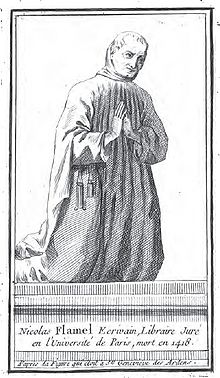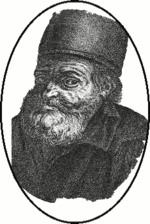Nicolas Flamel
You can help expand this article with text translated from the corresponding article in French. (November 2020) Click [show] for important translation instructions.
|
Nicolas Flamel | |
|---|---|
 Flamel as represented in 1402 on the portal of Sainte-Geneviève des Ardens (from Étienne François Villain, 1761) | |
| Born | c. 1330 Pontoise, France |
| Died | 22 March 1418 (aged 87–88) Paris, France |
| Spouse | Perenelle Flamel (m. 1368; died 1397) |
Nicolas Flamel (French: [nikɔla flamɛl]; c. 1330 – 22 March 1418)[1] was a French écrivain public, a draftsman of public documents such as contracts, letters, agreements and requests. He and his wife also ran a school that taught this trade.
Long after his death, Flamel developed a reputation as an alchemist believed to have created and discovered the philosopher's stone and to have thereby achieved immortality. These legendary accounts first appeared in the 17th century. According to texts ascribed to Flamel almost 200 years after his death, he had learned alchemical secrets from a Jewish converso on the road to Santiago de Compostela. He has since appeared as a legendary alchemist in various fictional works.
In modern historical publications Flamel is also often referred to as a copyist of manuscripts and a book seller, but research by M. and R. Rouse has demonstrated that this is not correct and that the very few historical documents that refer to him in this capacity do so mistakenly or are later forgeries.
Life
[edit]
The historical Flamel lived in Paris in the 14th and 15th centuries, and his life is well documented thanks to many surviving sources that mention him. He ran two shops as a scribe and married Perenelle before 1373.[2] She brought the wealth of two previous husbands to the marriage. The couple owned several properties and contributed financially to churches, sometimes by commissioning sculptures.[3] Later in life, they were noted for their wealth and philanthropy.
Flamel lived into his 80s, and in 1410 designed his own tombstone, which was carved with the images of Jesus Christ, Saint Peter and Saint Paul. The tombstone is preserved at the Musée de Cluny in Paris. Records show that Flamel died in 1418.[4] He was buried in Paris at the end of the nave of the former Church of Saint-Jacques-de-la-Boucherie.[5] His will, dated 22 November 1416, indicates that he was generous but that he did not have the extraordinary wealth of later alchemical legend. There is no indication that the real Flamel of history was involved in alchemy, pharmacy or medicine.[6]
Flamel was a real person, and he may have dabbled in alchemy, but his reputation as an author and immortal adept must be accepted as an invention of the seventeenth century.[6]
House in Paris
[edit]One of Flamel's houses still stands in Paris, at 51 rue de Montmorency. It is the oldest stone house in the city.[7] There is an old inscription on the wall, which states, "We, plowmen and women living at the porch of this house, built in 1407, are requested to say every day an 'Our Father' and an 'Ave Maria' praying God that His grace forgive poor and dead sinners." As of 2008, the ground floor housed a restaurant.[8] A Paris street near the Tour Saint-Jacques, the rue Nicolas Flamel, has been named after him; it intersects with the rue Pernelle, named after his wife.[8]
-
Flamel's Paris home, now a restaurant
-
A closer shot of the Auberge Nicolas Flamel, June 2008
-
Rue Nicolas Flamel street sign in Paris
-
Plaque on home
Posthumous reputation as an alchemist
[edit]
Legendary accounts of Flamel's life are based on 17th-century works, primarily Livre des figures hiéroglyphiques. The essence of his reputation are claims that he succeeded at the two goals of alchemy: that he made the philosopher's stone, which turns base metals into gold, and that he and his wife, Perenelle, achieved immortality through the "Elixir of Life".
An alchemical book, published in Paris in 1612 as Livre des figures hiéroglyphiques and in London in 1624 as Exposition of the Hieroglyphical Figures was attributed to Flamel.[9] It is a collection of designs purportedly commissioned by Flamel for a tympanum at the Cimetière des Innocents in Paris, long disappeared at the time the work was published. In the publisher's introduction, Flamel's search for the philosopher's stone was described. According to that introduction, Flamel had made it his life's work to understand the text of a mysterious 21-page book he had purchased in 1357, at the cost of two florins.[10] The introduction claims that, around 1378, he traveled to Spain for assistance with translation. On the way back, he reported that he met a sage, who identified Flamel's book as being a copy of the original The Book of Abraham the Jew. With this knowledge, over the next few years, Flamel and his wife allegedly decoded enough of the book to successfully replicate its recipe for the philosopher's stone, producing first silver in 1382 and then gold. Also, Flamel is said to have studied some texts in Hebrew.
The validity of this story was first questioned in 1761 by Etienne Villain. He claimed that the source of the Flamel legend was P. Arnauld de la Chevalerie, publisher of Exposition of the Hieroglyphical Figures, who wrote the book under the pseudonym Eiranaeus Orandus.[11] Other writers have defended the legendary account of Flamel's life, which has been embellished by stories of sightings in the 17th and 18th centuries and expanded in fictitious works ever since.
Flamel had achieved legendary status within the circles of alchemy by the mid 17th century, with references in Isaac Newton's journals to "the Caduceus, the Dragons of Flammel".[12] Interest in Flamel revived in the 19th century: Victor Hugo mentioned him in The Hunchback of Notre-Dame, Erik Satie was intrigued by Flamel,[13] and Albert Pike refers to Nicholas Flamel in his book Morals and Dogma of the Scottish Rite of Freemasonry. Flamel's reputation as an alchemist was further bolstered in the late 20th century by his depiction as the creator of the titular alchemical substance in the best-selling novel Harry Potter and the Philosopher's Stone[14] and its film adaptation. He also appears in the 2018 spinoff film Fantastic Beasts: The Crimes of Grindelwald, where he is portrayed by Brontis Jodorowsky.
Works ascribed to Flamel
[edit]
- Le Livre des figures hiéroglyphiques (The Book of hieroglyphic figures), first published in Trois traictez de la philosophie naturelle, Paris, Veuve Guillemot, 1612
- Le sommaire philosophique (The Philosophical summary), first published in De la transformation métallique, Paris, Guillaume Guillard, 1561
- Le Livre des laveures (The Book of washing), manuscript BnF MS. Français 19978
- Le Bréviaire de Flamel (Flamel's breviary), manuscript BnF MS. Français 14765
In popular culture
[edit]- Flamel has been portrayed in popular fiction as a legendary figure who holds the key to immortality or the philosopher's stone.
- In Victor Hugo's novel Notre Dame de Paris (1831), the tragic main character Claude Frollo is a young priest and alchemist who spends much of his time studying the carvings in Les Innocents, trying to fathom Flamel's secrets.
- In Harry Potter and Fantastic Beasts (1997–2022)
- Fullmetal Alchemist (2001–2010)
- The Secrets of the Immortal Nicholas Flamel (2007–2012)
- As Above, So Below (2014)
- The works of Nicolas Flamel are central to several missions found in the 2014 video game Assassin's Creed: Unity.
- Nicolas Flamel has also appeared in the video game Steelrising with regards to his legendary Philosopher Stone.
- Nicolas Flamel was also mentioned in the television series The Librarians being referenced as an immortal being that was able to be injured but could not die.
See also
[edit]Notes
[edit]- ^ According to Nigel Wilkins: Nicolas Flamel, des livres et de l'or, Chapter 1: De Paris.
- ^ Rouse, Mary (2006). The Well-Known Nicolas Flamel. p. 84.
- ^ Dixon 1994, p. xvi.
- ^ Cohen, Kathleen (1973). Metamorphosis of a death symbol: the transi tomb in the late Middle Ages and the Renaissance. University of California Press. p. 98.
- ^ Hauck, Dennis William (2008). The Complete Idiot's Guide to Alchemy. Penguin.
- ^ a b Dixon 1994, p. xvii.
- ^ , McAuliffe, Mary. Paris Discovered: Explorations in the City of Light. Princeton Book Company, 2006. ISBN 978-0-87127-287-4
- ^ a b Brooke, Anna E. (2008). Frommer's Paris and Disneyland Resort Paris With Your Family: From Captivating Culture to the Magic of Disneyland. New York: John Wiley & Sons. p. 134. ISBN 9780470714577.
- ^ Laurinda Dixon, ed., Nicolas Flamel, his Exposition of the Hieroglyphical Figures (1624) (New York: Garland) 1994.
- ^ Chisholm, Hugh, ed. (1911). . Encyclopædia Britannica. Vol. 10 (11th ed.). Cambridge University Press. p. 474.
- ^ Dixon 1994, p. xiv.
- ^ Newton, Isaac. "Sententiæ luciferæ et Conclusiones notabiles". Keynes MS 56 (quoted in Westfall, Never at Rest, p. 299). Retrieved May 15, 2011.
- ^ Wilkins 1993.
- ^ "Who is Nicholas Flamel? And other historical figures". nlm.nih.gov. United States National Library of Medicine. 24 August 2007. Retrieved 22 November 2014.
References
[edit]- Decoding the Past: The Real Sorcerer's Stone, November 15, 2006, History Channel video documentary
- The Philosopher's Stone: A Quest for the Secrets of Alchemy, 2001, Peter Marshall, ISBN 0-330-48910-0
- Creations of Fire, Cathy Cobb & Harold Goldwhite, 2002, ISBN 0-7382-0594-X
- Dixon, Laurinda (1994). Nicolas Flamel. His Exposition of the Hieroglyphicall Figures (1624). Garland Publishing.
- Gagnon, Claude, 'La Place de Nicolas Flamel dans l'histoire des sciences', Comprendre et maîtriser la nature au Moyen Âge: mélanges d'histoire des sciences offerts à Guy Beaujoyan, Paris: Droz, 1994, p. 531-539.
- Rouse, Mary, 'The Well-Known Nicolas Flamel', Patrons, Authors and Workshops: Books and Book Production in Paris around 1400, Leuven: Peeters, 2006, p. 69-89.
- Rouse, Richard H. and Mary A., Manuscripts and their Makers: Commercial Book Producers in Medieval Paris 1200-1500, Harvey Miller, 2000 (vol. 2, p. 101) ISBN 1872501419
- Wilkins, Nigel, Nicolas Flamel: des livres et de l'or, Éditions Imago, 1993, ISBN 2-902702-77-9
External links
[edit]- The Alchemy Web Site, alchemical writings ascribed to Flamel.
Lua error in Module:Navbox at line 192: attempt to concatenate field 'argHash' (a nil value).
- 1330s births
- 1418 deaths
- 14th-century French writers
- 15th-century French businesspeople
- French alchemists
- French booksellers
- French folklore
- Longevity myths
- Medieval European scribes
- Medieval occultists
- People from Pontoise
- 14th-century alchemists
- 15th-century alchemists
- 15th-century French scientists
- 14th-century French businesspeople




